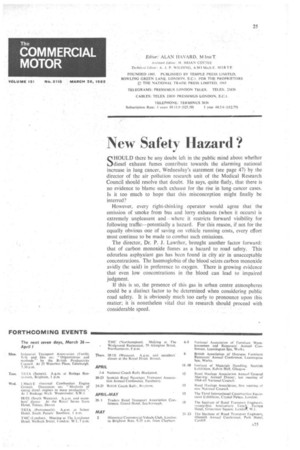New Safety Hazard ?
Page 27

If you've noticed an error in this article please click here to report it so we can fix it.
CMOULD there be any doubt left in the public mind about whether 1.3 diesel exhaust fumes contribute towards the alarming national increase in lung cancer, Wednesday's statement (see page 47) by the director of the air pollution research unit of the Medical Research Council should resolve that doubt. He says, quite flatly, that there is no evidence to blame such exhaust for the rise in lung cancer cases. Is it too much to hope that this misconception might finally be interred?
However, every right-thinking operator would agree that the emission of smoke from bus and lorry exhausts (when it occurs) is extremely unpleasant and—where it restricts forward visibility •for following traffic potentially a hazard. For this reason, if not for the equally obvious one of saving on vehicle running costs, every effort must continue to be made to combat such emissions.
The .director, Dr. P. 3. Lawther, brought another factor forward: that of carbon monoxide fumes as a hazard to road safety. This odourless asphyxiant gas has been found in city air in unacceptable concentrations. The haemoglobin of the blood seizes carbon monoxide avidly (he said) in preference to oxygen. There is growing evidence that even low concentrations in the blood can lead to impaired judgment.
If this is so, the presence of this gas in urban centre atmospheres could be a distinct factor to he determined when considering public road safety. It is obviously much too early to pronounce upon this matter; it is nonetheless vital that its research should proceed with considerable speed.




























































































































